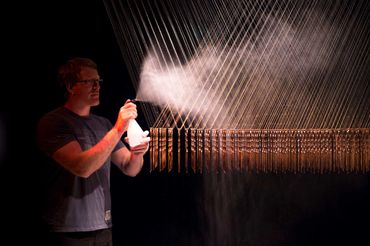
Collection
Relics of Decay (2016)
I, Michael Armstrong swear that I will well and truly serve Her Majesty Queen Elizabeth the Second, Her Heirs and Successors according to law, as a member of the Australian Army, and that I will resist her enemies and faithfully discharge my duty according to law. SO HELP ME GOD!
Relics of Decay (2016) by Michael Armstrong

Background
An estimated 262 Australian soldiers committed suicide between 1999 and 2016 as a result of the execution of their oath of service (above). Since then, the rate of suicide has increased dramatically and is not widely recorded or publicised.
Armstrong began work on Relics of Decay following the devastating announcement of a spate of suicides amongst those that he had served with in Afghanistan. He felt sickened at the thought, the impact and the ripple effect these deaths had on family and friends without public awareness or acknowledgement. He felt compelled to respond through his art. The blades, crafted from ceramic clay are an identical replica of the fighting knife Armstrong and others carried in Afghanistan. The blades formed part of several other works by Armstrong including Formation, Destruction and Corruption, all exhibited in 2016. Together, these works form the complete collection, Relics of Decay 2016.

Inspiration
Relics of Decay, 2016, explores the degrading effect military service has upon our service people, their families and society. Utilising the ceramic blade hung with wire as a metaphor for our fallen servicemen, 262 blades sit in formation. The suspended blades are misted with water daily causing them to slow rust and decay. The mist, condenses and drips, echoing the blades passage as their rust slowly stains a paper sheet lay beneath the sculpture forming a relic of their destruction.

Exhibit and purchase
Relics of Decay must be hung and the ritual completed daily for the works vision to become a reality - and a relic. In doing so, the blades will slowly vanish over time, dropping one by one, until only the memory of their passing, stains the paper relic remains.
Relics of Decay first exhibited in 2016 in Toowoomba then exhibited at The Australian War Memorial (AWM) in Canberra in 2017. It was not purchased by the AWM and is now in private storage until a permanent place of exhibition is offered for the work as a memorial to the fallen.
Artist context
The nature and reality of war relics
The blades first appeared in Michael's work in 2016 upon his return from operational service in the Middle East (Afghanistan 2013, Iraq 2015). He researched the nature of relics and artefacts with an interest in capturing the qualities associated with 'war relics' he had seen collected by people who crossed his path self entitled as 'war enthusiasts'.
"People collect and regard relics from war with an unusual fascination, often despite the terrible histories and acts of violence that can be associated with them," said Armstrong.
"It's a bizarre feeling looking and handling these objects and discussing their history in tones, that all but denies the violence through which they came into being.
"I believe artefacts can be used to distort and hide the true nature of war as well as providing possible insight into the experiences of our servicemen and women.
"I carried the blade used in this artwork during my deployment to Afghanistan and what resonates with me about it is the functionality of the blade - it's a fighting knife, useless in almost every other way that a knife could conceivably provide utility.
"For me it was a poignant reminder of the experiences we expose our service men and women to, and how difficult it can be for many of them to find utility once again within their peace time roles".
In the making





.jpg/:/cr=t:0%25,l:0%25,w:100%25,h:100%25/rs=w:370,cg:true)

A small studio for brave art
Mike Armstrong creates and teaches art from his studio-gallery and wellbeing space in Lyneham, Canberra, Australia.
